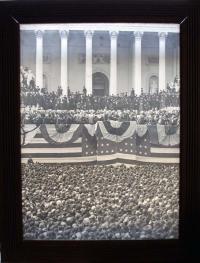Although it may be difficult to tell from a thumbnail, this is a mammoth plate (23 x 17 inch) collodion on glass positive photograph of Grover Cleveland’s 1885 inauguration as the twenty-second president of the United States. The spectacular image represents the end of one era and the beginning of another for American photography.
Mammoth glass plates had been used with great success since the 1860s when Carleton Watkins and other members of the government expeditions carried them through the West. Commercial photographers in the East, such as Mathew Brady, also used mammoth plates to make celebrity portraits on a grand scale.
However, for most photographers, glass plates were heavy, difficult to handle, and easily broken. Even with the development of an emulsion-coating machine in 1879, there was a demand for better, cheaper materials to support the light-sensitive chemistry. In 1885, George Eastman introduced his Eastman American Film and in 1888, offered a camera that held a pre-coated roll of his flexible film. Now anyone who could afford to buy the camera could make photographs.
It is not surprising to find this seminal photograph at Princeton. When he retired from office, Cleveland chose Princeton, New Jersey, for his home and served for a time as a trustee of Princeton University. When he died in 1907, he was buried in the Princeton cemetery of the Nassau Presbyterian Church.
Cleveland’s papers are available in the Grover Cleveland collection, 1860-1907 (Manuscripts Collection MSS C0237). In addition, the books from his personal library are now part of Princeton’s rare books collections, including his copy of the 1885 Message from the President of the United States to the two Houses of Congress at the commencement of the first session of the forty-ninth Congress (Rare Books (Ex) CL 1090.24.9).
For more information on Cleveland’s connections with Princeton, see http://etcweb.princeton.edu/CampusWWW/Companion/cleveland_grover.html

